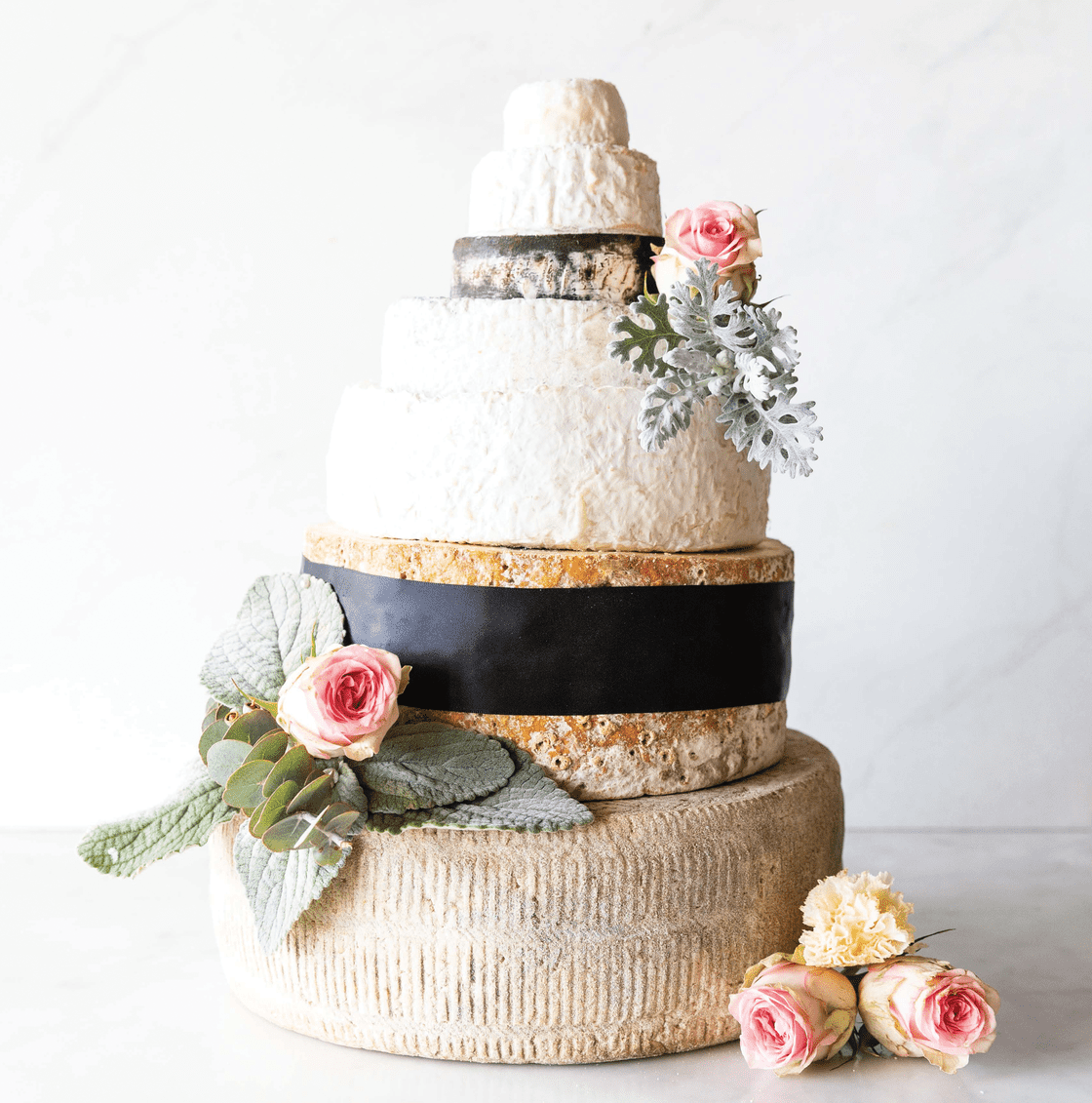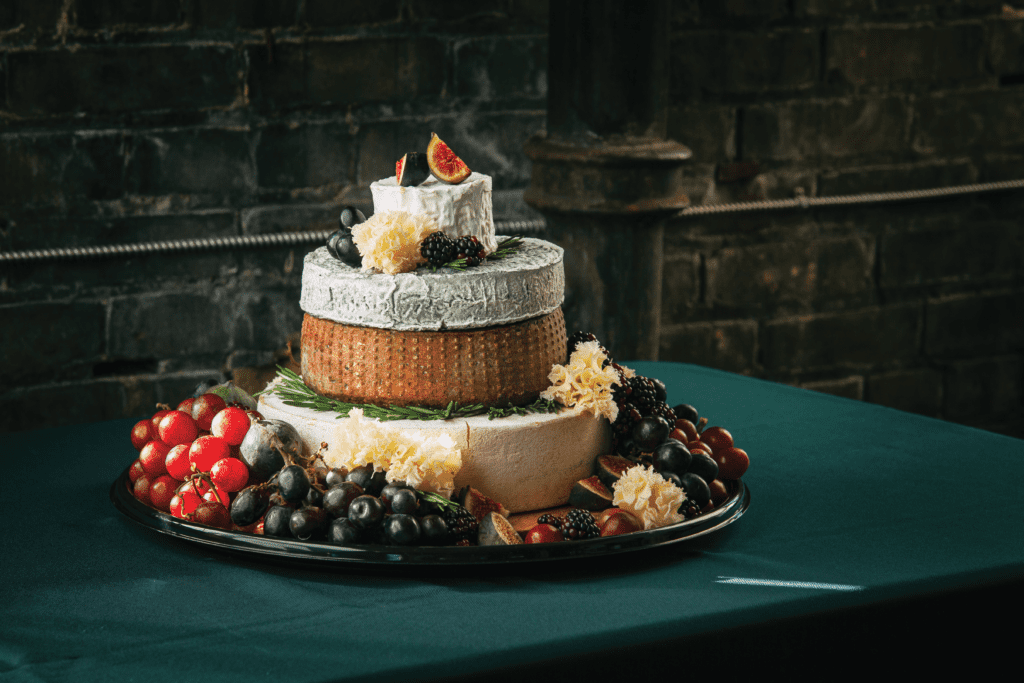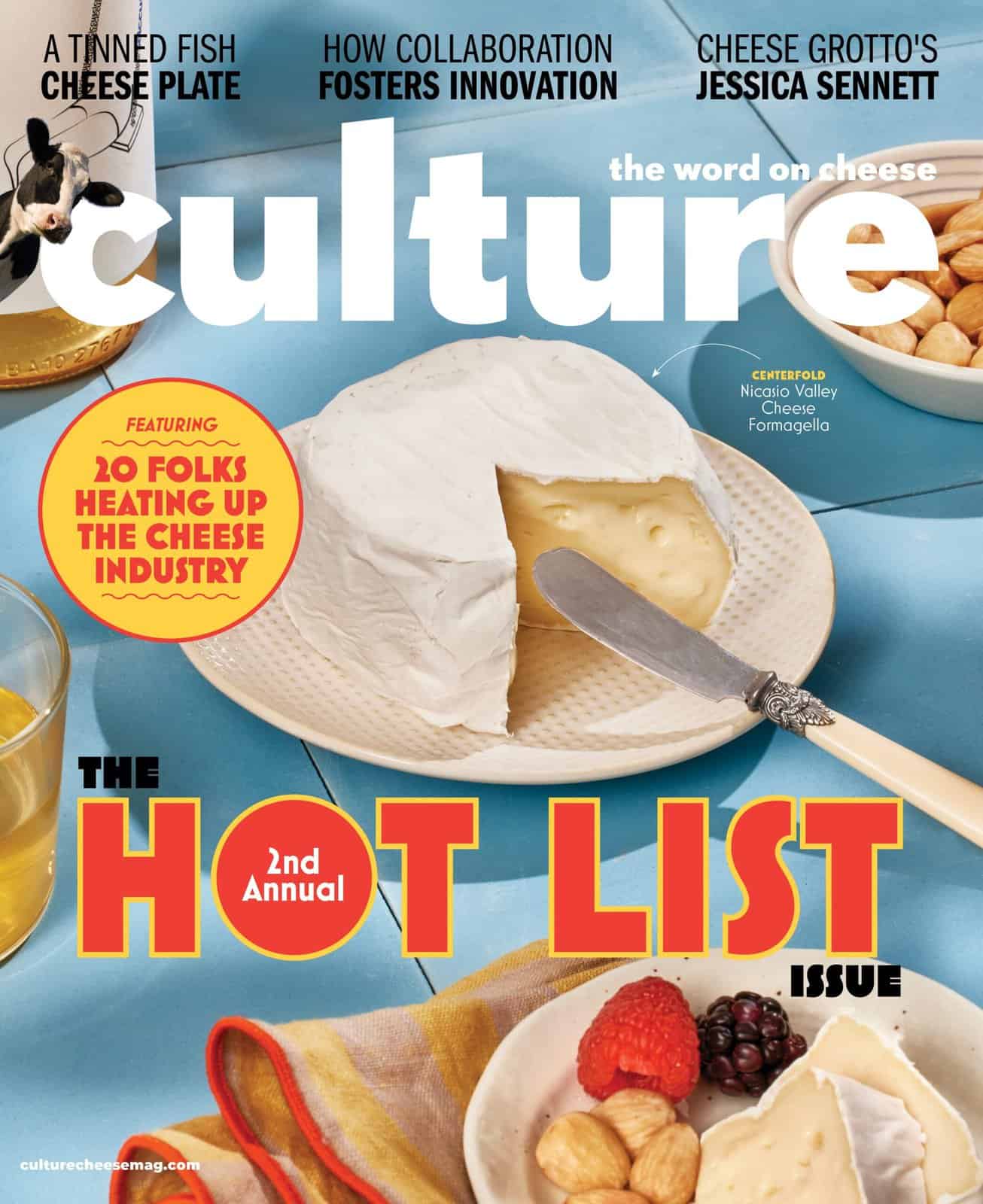
Photo from @harperandblohm Instagram
Celebrations call for cake, but that cake does not have to be sweet. Beyond the elaborate cheeseboard, savory wheels and wedges can be a party centerpiece, and increasingly, the multi-tiered wedding cake is being swapped for a tower of cheese. Instead of choosing between vanilla and chocolate or marzipan and whipped cream, brides, grooms, and party hosts are tasting gooey washed rinds, spicy blues, and nutty Alpine styles to decide which layers will make up their “cake.”
Cheese celebration cakes seem to have started in the UK. The trend began around 20 years ago but has taken off in the last 10 years, both in the UK and US. These towers of cheese are particularly popular in my home region, Yorkshire. Here we traditionally eat fruitcake with Wensleydale cheese, so it is not surprising that some have gone as far as to replace the cake itself with cheese.
Cheese has a number of advantages over cake. A cheese tower can be assembled on site, eliminating worries about the car jolting, or someone tripping while carrying the cake. The huge variety of cheeses available caters to individual tastes. Cheese is versatile, eaten at any time of day. “A cheese tower is at home alongside cocktails, as part of a buffet or at the end of a formal dinner,” says Shannon Berry, Wisconsin cheese specialist at the Dairy Farmers of Wisconsin (DFW) and a former cheesemonger at Fromagination in Madison, Wisconsin. It may also be more economical; you are paying for the cheese rather than the labor involved in decorating a traditional cake.

Cheese Lovers
After Michelle Taylor’s daughter, Heather, was married in New Zealand, Michelle arranged a second ceremony for her at home in the UK. “Heather is a cheese fanatic,” her mother says. “She had a cake in New Zealand, so we wanted something different for Yorkshire.” Michelle visited the Courtyard Dairy in Settle to taste a range of cheeses. She collected the cheese a few days before the event, then assembled it at the venue on the day of the reception, using fresh and dried fruit to decorate the tiers and serve with the cheese. “I was delighted,” says Heather. “Most of the cheese was eaten on the day, what was left made a great family supper later in the week.”
The Courtyard Dairy offers 15 cheese cake designs on their website, ranging from $41 for a two-tier mini tower of brie-style Finn and Dales-style Fellstone, to $531 for the seven-tier “Diamond” tower: Baron Bigod Brie, Kirkham’s Lancashire, St. Andrew’s Cheddar, Young Buck (a blue), Farmhouse Wensleydale, and Tunworth Camembert, topped with a wrinkly, pungent Langres. Customers can also create their own bespoke towers. Monique and Julian Gardela are planning a party for their English friends following their wedding in the Netherlands. The award-winning cheesemonger helped the couple determine what would work for their budget and how the cheeses would stack. They decided upon a base of Old Winchester (a cross between gouda, parmesan, and cheddar), Old Roan Wensleydale, Stichelton blue and finally a Dorstone goat’s cheese to top the tower.
Seven years ago, cheesemonger Stephen Fleming, created a cheese tower for his own wedding. In the last five years he has seen a growing demand for cheese celebration cakes. “I now organize two or three cheese consultations every week and have orders as far ahead as 2024,” he says. His shop, George and Joseph, in Leeds, provides towers for celebrations including birthdays, anniversaries, weddings, and christenings. He encourages customers to create their own towers by listing the diameters of all the cheeses the shop stocks on their website. Sizes vary from a Sparkenhoe Red Leicester with a diameter of about 18 inches to a tiny 2-inch Crottin.

Choosing Your Cheese
The cheesemongers I spoke with emphasized the need for balance—a balanced variety of cheeses so that everyone has something they enjoy, and a tower that will structurally balance well.
For the latter it is important to start with a hard cheese and use soft cheeses as toppers. Cheddar cheeses often make a good base as they are supplied in large wheels. DFW’s Shannon Berry recommends Hook’s Cheddar, available in various vintages. Gloucester and Double Gloucester also work well.
To make a visual impact it’s also important to consider color. Murray’s Maria Gaube suggests Humboldt Fog from Cypress Grove as a popular white cheese. Extra color might come from a blue such as Stilton or the range of blue cheeses produced by Roth in Wisconsin. Ash can add another tone, either as a covering or a line through the centre, as in Morbier.
Wensleydale and Lancashire make good middle layers, adding a crumbly texture but forming solid blocks. They also pair well with savory and sweet, including fruitcake.
Photo from @saltpigdeli Instagram
Personal Touches
Both the Courtyard Dairy and George and Joseph often sell towers constructed only of cheeses produced in Yorkshire—an example of celebrating place through cheese.
Stateside, Murray’s Cheese in New York City finds that many of the customers ordering a celebration cheese cake have fond memories of visiting their Greenwich Village store. “Murray’s is an institution; they often came here as children and have fond memories,” says Maria Gaube, Murray’s senior catering manager. “They may have moved away but want to maintain a connection.” Gaube says that many brides ask for cheeses with white hues, such as bloomy rinds, to keep the look traditional despite the change in cake from sweet to savory. Murray’s cave-aged cheeses, including Reserve Cornelia, which originates at Point Reyes Farmstead Creamery in California, and Reserve Hudson Flower, a sheep’s milk cheese from Old Chatham in New York, are particularly popular. The addition of herbs, flowers and fruit can echo bridal bouquets.
Not surprisingly cheese celebration cakes are popular in Wisconsin, America’s Dairyland. “Many people in Wisconsin have a link to the dairy industry, they want to celebrate their heritage, and use cheese towers as a way to do this,” says Berry, adding that the captive audience at a private event offers an opportunity for cheese education. “Something I often have to explain is that cheese does not have to be chilled; the flavor develops as it sits at room temperature.”
One of her favorite cheese tower creations is “The Vineyard,” a cheese- and-wine-pairing beauty detailed on DFW’s website. “I love the elegance of it,” Berry says. “The bottom wheel is Sartori Merlot BellaVitano, which is a crowd-pleasing parmesan/cheddar hybrid washed in merlot wine, a true Wisconsin original. In the middle is Uplands Pleasant Ridge Reserve (the most-awarded cheese in the US), which has a gorgeous washed rind that lends a luscious, brothy flavor to this grass- fed Beaufort-style cheese. Then at the top is Door Artisan Cheese Company Roseate which is a wine-soaked, cave- aged asiago.” The addition of a bunch of grapes extends the vineyard theme and fresh figs complement both the color and taste of the cheese.

Building Your Tower
The first layer will need to be the largest and hardest wheel of cheese. Additional layers will become increasingly smaller and softer. Decorations can either be added to the cheese or the layers can be spaced using glass bowls or doweling, so that decorative layers lay between the cheese.
You should use 2 to 4 ounces (50 to 100 grams) per person, depending upon whether the tower will be an accompaniment or the main event. Assemble the cheese tower at least two to three hours before it will be cut to enable it to come up to room temperature. Use a cake stand or board as a base.
Cheese layers are usually round, but you can experiment with other shapes. Smaller cheeses are sometimes available in pyramid, sphere, or heart shapes. You can also assemble wedges to make a layer.
Decorations might include edible or artificial flowers, dried or fresh fruit, and ribbons. Color schemes can be planned using decorations as well as the color of the cheese.
Photo from @brieandbanquete Instagram
Layering Up
Back in Yorkshire, Rachel Cheshire has set up Celebration Cheeses, a bespoke service for providing cheese towers. “I describe myself and my staff as cheese architects,” she says. She has a portfolio of 400 cheeses to offer customers, although some, including Wensleydale Creamery’s Fountains Gold Cheddar with Caramelised Onion, the original Wensleydale, and the Cheshire Cheese Company’s dramatic black Charcoal Cheddar are particularly popular with her customers. Another favorite cheese in her structures is Baron Bigod Brie, from Suffolk, which “is not as soft and holds its shape better than most bries.”
Cheshire arranges consultations with tastings and then plans towers with her clients based on taste preferences, visual impact, and budget. She matches decorations, which include real, edible, and artificial flowers, feathers, and fruit, to the cheese and floral bouquets, and also provides crackers and chutneys to accompany the cheese.
The cheese tower trend has already evolved in the place where it all began— and beyond. Since fruit cake and pork pie often accompany cheese in Yorkshire, Cheshire and Fleming offer towers that incorporate these elements as cake tiers. During, and since COVID-19, smaller cakes have become popular. George and Joseph in Yorkshire and Murray’s in New York now sell small towers for intimate gatherings, including Valentine’s Day towers for two. Gaube has also started to see cheese towers ordered as groom’s cakes, “cheese for him and cake for her.”
Many people, of course, will continue to choose a traditional sweet cake as a celebration centerpiece or a wedding grand finale. But as interest in and passion for great cheese continues to grow, it’s a good bet we’ll see more cheese towers being ceremoniously sliced by bride and groom. Now, all someone has to do is figure out how to replicate the classic wedding cake face smash with cheese.




